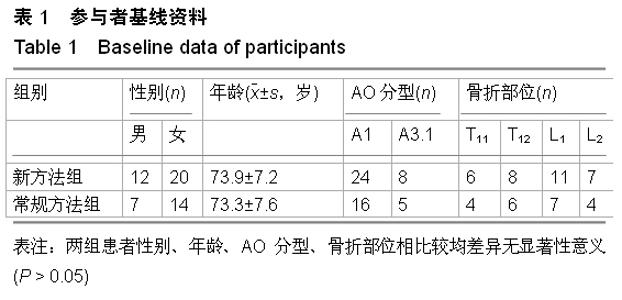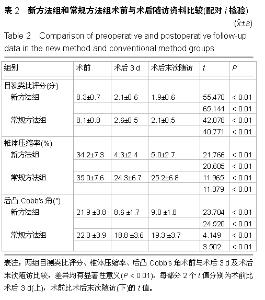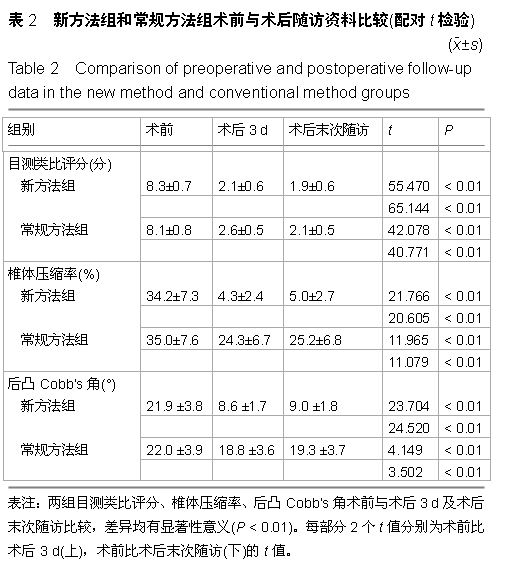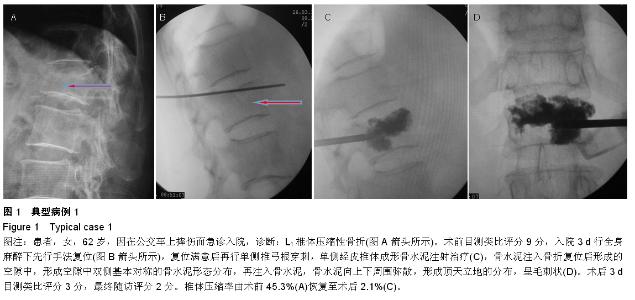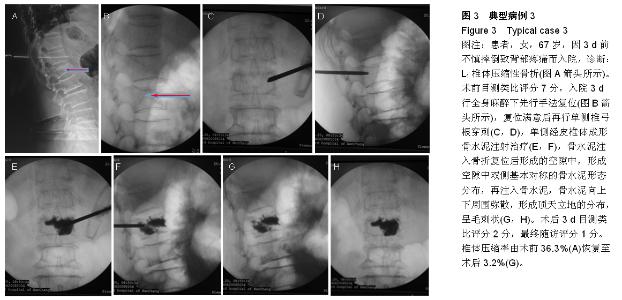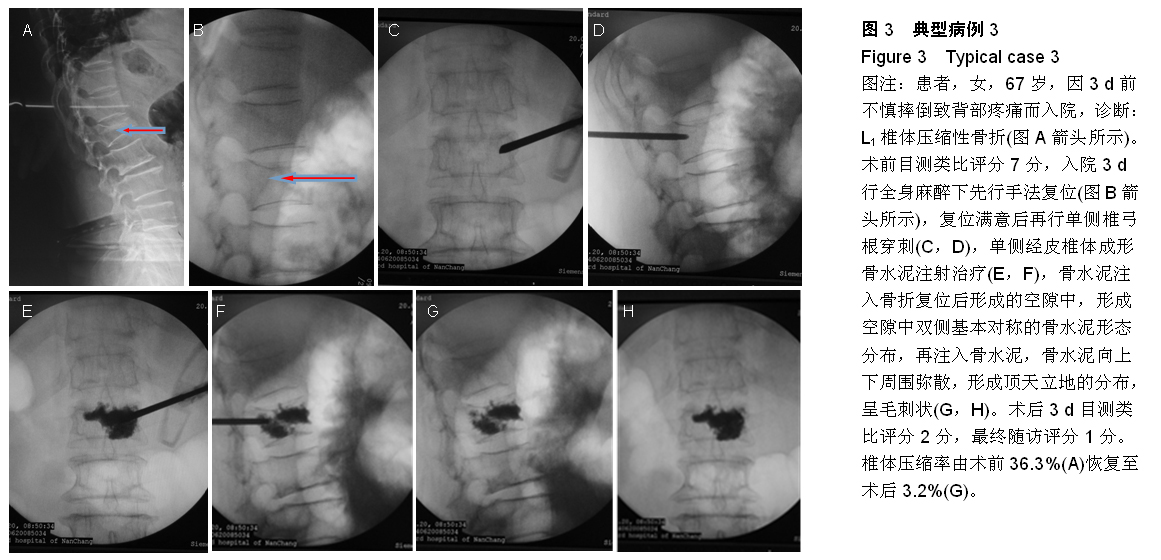Chinese Journal of Tissue Engineering Research ›› 2015, Vol. 19 ›› Issue (31): 4960-4966.doi: 10.3969/j.issn.2095-4344.2015.31.008
Previous Articles Next Articles
Unilateral percutaneous vertebroplasty for osteoporotic vertebral compression fractures: less bone cement leakage and ideal recovery
Wu Hong, Yuan Yuan, Liu Li-jin, Yan Liang, Xiong Li-wei, Zou Zhi-yuan, Min Zhi-hai
- Department of Orthopedics, the Nanchang Third Hospital, Nanchang 330009, Jiangxi Province, China
-
Received:2015-06-20Online:2015-07-23Published:2015-07-23 -
Contact:Wu Hong, Department of Orthopedics, the Nanchang Third Hospital, Nanchang 330009, Jiangxi Province, China -
About author:Wu Hong, M.D., Associate chief physician, Department of Orthopedics, the Nanchang Third Hospital, Nanchang 330009, Jiangxi Province, China -
Supported by:the Nanchang Technology Support Program-Technical Field of Social Development in 2014, No. 2014-SFJS-SWYY-002
CLC Number:
Cite this article
Wu Hong, Yuan Yuan, Liu Li-jin, Yan Liang, Xiong Li-wei, Zou Zhi-yuan, Min Zhi-hai. Unilateral percutaneous vertebroplasty for osteoporotic vertebral compression fractures: less bone cement leakage and ideal recovery [J]. Chinese Journal of Tissue Engineering Research, 2015, 19(31): 4960-4966.
share this article
| [1] Kovacs FM, Abraira V, Zamora J, et al. Correlation between pain, disability, and quality of life in patients with common low back pain. Spine. 2004;(29):206-210.
[2] 秦子琈,徐有俊.老年骨质疏松症的危险因素研究[J].中国医学创新,2011,8(34):31-33.
[3] 高万旭,宓士军,高景春,等.经皮椎体成形治疗高龄骨质疏松性椎体压缩骨折[J].实用骨科杂志,2010,16(4):288-289.
[4] 刘文贵,吕锦瑜,孙建华,等.PVP与保守方法治疗骨质疏松性胸腰椎椎体压缩骨折的疗效比较[J].中国脊柱脊髓杂志,2012,22(10): 914-918.
[5] Weisskopf M, Ohnsorge JA, Niethard FU. Intravertebral pressure during vertebroplasty and balloon kyphoplasty:an in vitro study. Spine. 2008;33:178-182.
[6] Chen D, An ZQ, Song S, et al. Percutaneous vertebroplasty compared with conservative treatment in patients with chronic painful osteoporotic spinal fractures. J Clin Neurosci. 2014; 21(3):473-477.
[7] Tan HY, Wang LM, Zhao L, et al. A prospective study of percutaneous vertebroplasty for chronic painful osteoporotic vertebral compression fracture. Pain Res Manag. 2015;20(1): 8-11.
[8] 朱洲,王生介,厉晓龙,等.聚甲基丙烯酸甲酯骨水泥椎体成形与保守治疗胸腰椎体新鲜骨质疏松性压缩骨折的比较[J].中国组织工程研究,2014,18(39):6271-6275.
[9] Stevenson M, Gomersall T, Lloyd Jones M, et al. Percutaneous vertebroplasty and percutaneous balloon kyphoplasty for the treatment of osteoporotic vertebral fractures: a systematic review and cost-effectiveness analysis. Health Technol Assess. 2014;18(17):1-290.
[10] 李卉,顾一峰,李永东,等.比较经皮椎体成形与保守治疗对慢性疼痛性骨质疏松性椎体骨折患者疗效的非随机前瞻性试验[J].介入放射学杂志,2012,21(11):921-926.
[11] Ryu KS, Park CK. The prognostic factors influencing on the therapeutic effect of percutaneous verteboplasty in treating osteoportic vertebral compression fractures. J Korean Neurosurg Soc. 2009;45(1):16-23.
[12] Joseph RN, Swift AJ, Maliakal PJ. Single centre prospective study of the efficacy of percutaneous cement augmentation in the treatment of vertebral compression fractures. Br J Neurosurg. 2013,27(4):459-464.
[13] 杜曼•吐鲁木汗,祖帕尔•苏来曼,塔扎别克.后凸成形与椎体成形治疗骨质疏松性椎体压缩骨折的Meta分析[J].中国组织工程研究,2014,18(13):2089-2095.
[14] 彭小忠,陈明,武振国,等.经皮椎体成形102例中22例骨水泥渗漏原因[J].中国组织工程研究与临床康复,2011,15(8):1515-1518.
[15] 周英杰,赵刚,李森,等.经皮聚甲基丙烯酸甲酯骨水泥椎体成形结合手法牵引复位治疗骨质疏松性胸腰椎压缩骨折[J].中国组织工程研究,2012,16(21):3823-3827.
[16] 李涛,朱裕成,郑红兵,等.经皮椎体后凸成形中单双侧经椎弓根穿刺路径的选择[J].中国矫形外科杂志,2009,17(24):1863-1865.
[17] 王珏,刘杨青,原涟靖,等.经皮椎体成形单侧人路穿刺路径方法的选择及疗效[J].实用医学杂志,2013,29(7):1144-1146.
[18] 郝定均,刘摇鹏,贺宝荣,等.陈旧性与新鲜性压缩骨折行椎体成形的临床对比研究[J].脊柱外科杂志,2012,10(2):83-86.
[19] Lieberman IH, Dudeney S, Reinhardt MK, et al. Initial outcome and efficacy of “kyphoplasty” in the treatment of painful osteoporotic vertebral compression fracture. Spine. 2001;26:1631-1638.
[20] Kuklo TR, Polly DW, Owens BD, et al. Measurement of thoracic and lumbar variability. Spine. 2001;26:61-65.
[21] 黄洪斌,范顺武,鲍丰,等.椎体成形结合体位复位治疗创伤性胸腰椎骨折[J].中华骨科杂志,2008,28(1):20-24.
[22] Xiao H, Yang J, Feng X, et al. Comparing complications of vertebroplasty and kyphoplasty for treating osteoporotic vertebral compression fractures: a meta-analysis of the randomized and non-randomized controlled studies. Eur J Orthop Surg Traumatol. 2014.
[23] Liliang PC, Su TM, Liang CL, et al. Percutaneous vertebroplasty improves pain and physical functioning in elderly osteoporotic vertebral compression fracture patients. Gerontology. 2005;51:34-39.
[24] 陈卫,倪才方,王煊,等.经皮椎体成形及后凸成形治疗骨质疏松性椎体压缩骨折的临床对比研究[J].中华放射学杂志,2011,45(9): 858-862.
[25] 吴海辉,吴晓,吴晓天,等.经皮椎体后凸成形与经皮椎体成形治疗骨质疏松性胸腰段骨折的疗效对比研究[J].临床和实验医学杂志,2014,13(9):737-740.
[26] Galin SR, Yuan HA, Reiley MA. New technologies in spine:kyphoplasty and vertebruplasty for the treatment of painful osteoporotic compression fractures. Spine. 2001;26: 1511-1515.
[27] Foumey DR. Schomer DF, Nader R. et al. Percutaneous vertebroplasty and kyphoplasty for painful vertebral body fractures in cancer patients. J Neurosurg. 2003;98(1 Suppl): 21-30.
[28] Movrin I, Vengust R, Komadina R. Adjacent vertebral fractures after percutaneous vertebral augmentation of osteoporotic vertebral compression fracture: a comparison of balloon kyphoplasty and vertebroplasty. Arch Orthop Trauma Surg. 2010;130:1157-1166.
[29] Huang Z, Wan S, Ning L, et al. Is unilateral kyphoplasty as effective and safe as bilateral kyphoplasties for osteoporotic vertebral compression fractures? A meta-analysis. Clin Orthop Relat Res. 2014;472(9):2833-2842.
[30] 廖旭昱,周雷杰,马维虎,等.经皮椎体后凸成形中单侧经椎弓根穿刺角度与骨水泥分布情况的关系[J].临床骨科杂志,2012,15(3): 241-244.
[31] Kim YY,Rhyu KW.Recompression of vertebral body after balloon kyphoplasty for osteoporotlc vertebral compression fracture. Eur Spine J. 2010;19(11):1907-1912.
[32] Nieuwenhuijse MJ, Muijs SP, van EAR, et al. A clinical comparative study on low versus medium viscosity polymethylmetacrylate bone cement in percutaneous vertebroplasty: viscosity associated with cement leakage. Spine (Phila Pa 1976). 2010;35(20):E1037-E1044.
[33] Gravius S, Kraska N, Maus U, et al. Intravertebral pressure during vertebroplasty - an in-vitro study. Z Orthop Unfall. 2009;147(1):43-47.
[34] Jin YJ, Yoon SH, Park KW, et al. The volumetric analysis of cement in vertebroplasty: relationship with clinical outcome and complications. Spine (Phila Pa 1976). 2011;36(12):E761- E772.
[35] Molly S, Mathis JM, Belkoff SM. The effect of vertebral body percentage fill in mechanical behavior during percutaneous vertebro plasty. Spine. 2003;28:1549-1554.
[36] Komemushi A, Tanigawa N, Kariya S, et al. Percutaneous vertebroplasty for compression fracture: analysis of vertebral body volume by CT volumetry. Acta Radiol. 2005;46(3):276- 279.
|
| [1] | Xu Feng, Kang Hui, Wei Tanjun, Xi Jintao. Biomechanical analysis of different fixation methods of pedicle screws for thoracolumbar fracture [J]. Chinese Journal of Tissue Engineering Research, 2021, 25(9): 1313-1317. |
| [2] | Lu Dezhi, Mei Zhao, Li Xianglei, Wang Caiping, Sun Xin, Wang Xiaowen, Wang Jinwu. Digital design and effect evaluation of three-dimensional printing scoliosis orthosis [J]. Chinese Journal of Tissue Engineering Research, 2021, 25(9): 1329-1334. |
| [3] | Zhang Tongtong, Wang Zhonghua, Wen Jie, Song Yuxin, Liu Lin. Application of three-dimensional printing model in surgical resection and reconstruction of cervical tumor [J]. Chinese Journal of Tissue Engineering Research, 2021, 25(9): 1335-1339. |
| [4] | Yao Rubin, Wang Shiyong, Yang Kaishun. Minimally invasive transforaminal lumbar interbody fusion for treatment of single-segment lumbar spinal stenosis improves lumbar-pelvic balance [J]. Chinese Journal of Tissue Engineering Research, 2021, 25(9): 1387-1392. |
| [5] | Wang Haiying, Lü Bing, Li Hui, Wang Shunyi. Posterior lumbar interbody fusion for degenerative lumbar spondylolisthesis: prediction of functional prognosis of patients based on spinopelvic parameters [J]. Chinese Journal of Tissue Engineering Research, 2021, 25(9): 1393-1397. |
| [6] | Chen Jinping, Li Kui, Chen Qian, Guo Haoran, Zhang Yingbo, Wei Peng. Meta-analysis of the efficacy and safety of tranexamic acid in open spinal surgery [J]. Chinese Journal of Tissue Engineering Research, 2021, 25(9): 1458-1464. |
| [7] | Tang Hui, Yao Zhihao, Luo Daowen, Peng Shuanglin, Yang Shuanglin, Wang Lang, Xiao Jingang. High fat and high sugar diet combined with streptozotocin to establish a rat model of type 2 diabetic osteoporosis [J]. Chinese Journal of Tissue Engineering Research, 2021, 25(8): 1207-1211. |
| [8] | Li Zhongfeng, Chen Minghai, Fan Yinuo, Wei Qiushi, He Wei, Chen Zhenqiu. Mechanism of Yougui Yin for steroid-induced femoral head necrosis based on network pharmacology [J]. Chinese Journal of Tissue Engineering Research, 2021, 25(8): 1256-1263. |
| [9] | Zeng Yanhua, Hao Yanlei. In vitro culture and purification of Schwann cells: a systematic review [J]. Chinese Journal of Tissue Engineering Research, 2021, 25(7): 1135-1141. |
| [10] | Zhang Wei, Hu Jiang, Tang Liuyi, Wan Lun, Yu Yang, Lin Shu, Tang Zhi, Wang Fei. Advantages of robot assisted percutaneous biopsy in the diagnosis of spinal lesions [J]. Chinese Journal of Tissue Engineering Research, 2021, 25(6): 844-848. |
| [11] | Hou Guangyuan, Zhang Jixue, Zhang Zhijun, Meng Xianghui, Duan Wen, Gao Weilu. Bone cement pedicle screw fixation and fusion in the treatment of degenerative spinal disease with osteoporosis: one-year follow-up [J]. Chinese Journal of Tissue Engineering Research, 2021, 25(6): 878-883. |
| [12] | He Li, Tian Wei, Xu Song, Zhao Xiaoyu, Miao Jun, Jia Jian. Factors influencing the efficacy of lumbopelvic internal fixation in the treatment of traumatic spinopelvic dissociation [J]. Chinese Journal of Tissue Engineering Research, 2021, 25(6): 884-889. |
| [13] | Li Shibin, Lai Yu, Zhou Yi, Liao Jianzhao, Zhang Xiaoyun, Zhang Xuan. Pathogenesis of hormonal osteonecrosis of the femoral head and the target effect of related signaling pathways [J]. Chinese Journal of Tissue Engineering Research, 2021, 25(6): 935-941. |
| [14] | Xiao Fangjun, Chen Shudong, Luan Jiyao, Hou Yu, He Kun, Lin Dingkun. An insight into the mechanism of Salvia miltiorrhiza intervention on osteoporosis based on network pharmacology [J]. Chinese Journal of Tissue Engineering Research, 2021, 25(5): 772-778. |
| [15] | Liu Bo, Chen Xianghe, Yang Kang, Yu Huilin, Lu Pengcheng. Mechanism of DNA methylation in exercise intervention for osteoporosis [J]. Chinese Journal of Tissue Engineering Research, 2021, 25(5): 791-797. |
| Viewed | ||||||
|
Full text |
|
|||||
|
Abstract |
|
|||||
